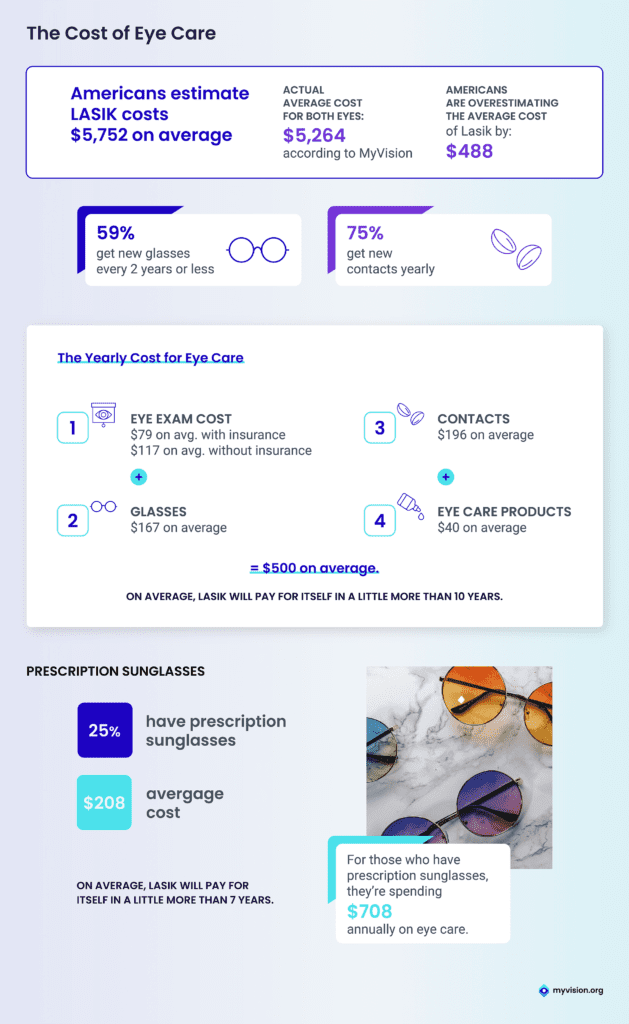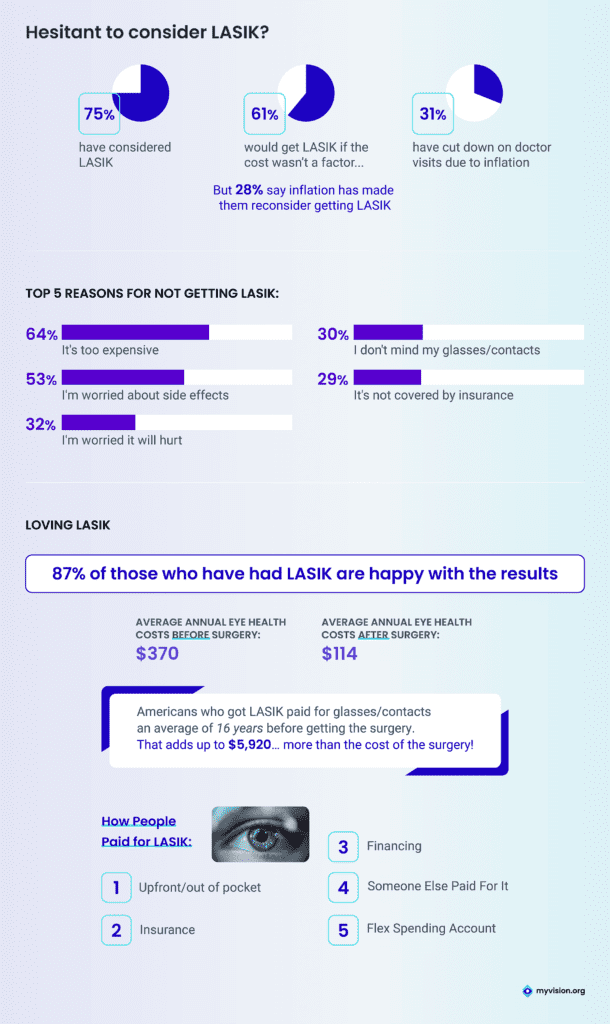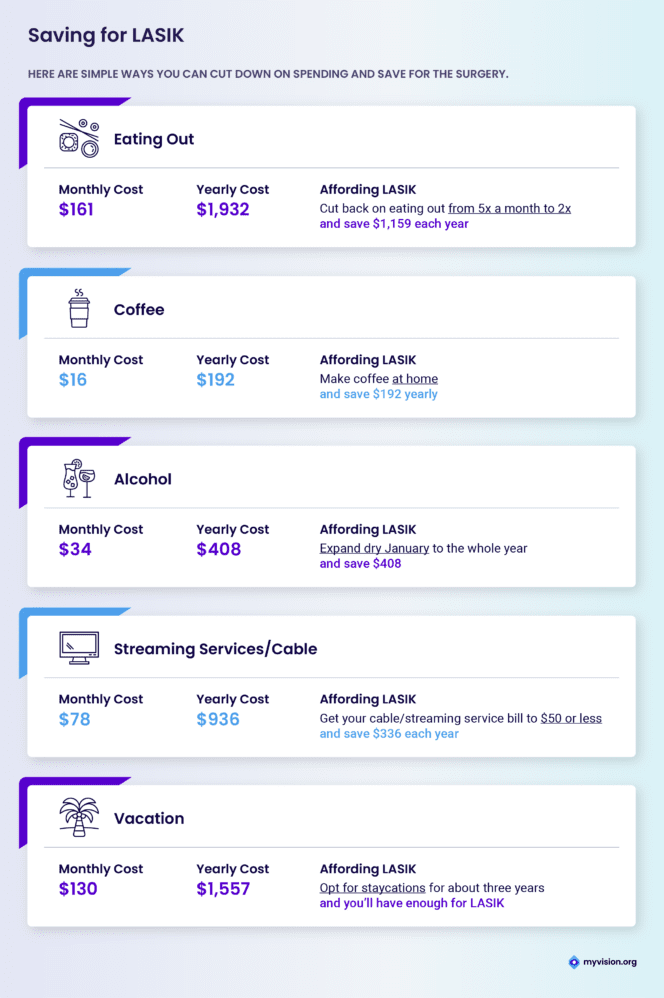While glasses and contacts are game changers for people with bad vision, the costs add up over time. Every year, many Americans have to pay for an eye exam, new lenses for their glasses, a year’s supply of contacts, and maybe even prescription sunglasses. When you add up the costs, it’s safe to say it’s not cheap.
A new survey of more than 1,050 people with bad or corrected vision found they are paying about $500 every year for their eyesight. But with LASIK, that could cut down that cost to just about $100 a year. We’ll show you how a few simple lifestyle changes could help you save for the surgery.
The Case for LASIK

LASIK isn’t cheap, but it definitely pays off in the long run. Americans estimated the total surgery cost $5,752 on average, but they overestimated it by nearly $500. LASIK costs anywhere from $1,000 to $4,000 per eye. The nationwide average is $5,264 total.
We get it. It sounds like a lot of money, and it is a lot of money! But let’s put it in perspective. On average, Americans with bad vision start having problems seeing far away anywhere from their early school years to their teens. Let’s say people start having trouble seeing at 15 years old. That means they had to start spending money annually on an eye exam ($79 with insurance, $117 without), glasses ($167 on average) and/or contacts ($196 on average), and eye care products ($40). That’s about $500 a year. The Centers for Disease Control estimates the average life expectancy for Americans is 77 years old. So, over a lifetime people with bad vision end up paying $31,000 on eye care!
But if they get LASIK, the surgery will pay for itself in a little more than 10 years. It would pay for itself even faster if you’re paying extra for things like prescription sunglasses.
LASIK Pros and Cons

Three-quarters (75%) of people with glasses or contacts have considered LASIK. Right now, the top reason people are putting off the surgery is cost, and inflation is having an impact. More than 3 out of 5 (61%) said they would get LASIK if the cost wasn’t a factor, and 28% say inflation has made them reconsider the surgery. Other top concerns about LASIK include side effects and pain.
It’s not only elective surgeries like LASIK that are being impacted by the current environment. Nearly 1 out of 3 people (31%) admitted they have cut down on doctor visits because of inflation too.
People who have already gotten LASIK said they went from paying $370 a year in eye care costs to only $114. The top three ways people paid for LASIK were upfront or out of pocket (60%), insurance (15%), and financing (13%).
The majority were pleased with the results. Nearly 90%of those who have gotten LASIK reported they were happy with how their eyes turned out after the surgery.
Affording LASIK

While LASIK is expensive, it’s not unattainable. There are some simple changes you can make to your lifestyle to save up for the surgery. We asked Americans to estimate how much they spend monthly and yearly on things like take-out, coffee, streaming services, and vacation.
People estimated they eat out about 5 times a month and spend about $161 monthly at restaurants and take-out. That adds up to $1,932 a year. If you cut back on eating out to just 2 times a month you could save $1,159 each year! Skipping Starbucks and opting for coffee at home could add an extra $192 to your account, and attempting a dry 2023 instead of just dry January could help you save $408 a year.
Most Americans spend an average of $78 monthly on streaming services and cable. It doesn’t sound like a lot, but that adds up to $936 a year. If you cut back on a streaming service or 2 and got your monthly bill down to $50 a month, you could save $336 each year!
As for vacations, Americans spend an annual average of $1,557 on trips. If you opted for staycations, you’d save enough money for the surgery in about 3 years. If that’s not realistic you could cut down your vacations to just $1,000 each year, and save an extra $500. Just think, after LASIK, the next time you visit Mount Rushmore or the Grand Canyon you won’t have to squint!
There’s not a one-size-fits-all saving solution, but consciously cutting back a little here and there could help you save what you need for LASIK. It’s a long-term investment, but it can pay itself off in the long run.
Methodology
In July 2022, we surveyed 1,058 people with vision problems or corrected vision about the costs of eye care. Respondents ranged in age from 18 to 82 with an average age of 39. 48% were women, 49% men, 2% nonbinary, and 1% transgender. The household income of 31% was $40,000 or less, 19% reported $40,001-$60,000, 14% reported $60,001 – $80,000, 13% reported $80,001-$100,000, and 24% reported $100,001 or more.
For media inquiries, please contact media@digitalthirdcoast.net.
Fair Use
When using this data and research, please attribute it by linking to this study and citing myvision.org.
Last Updated September 21, 2022
Note: This page should not serve as a substitute for professional medical advice from a doctor or specialist. Please review our about page for more information.